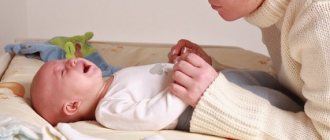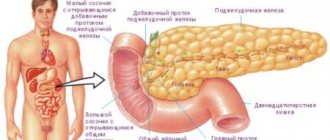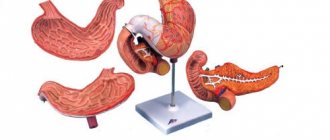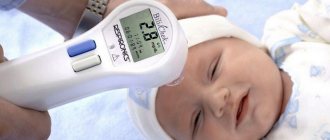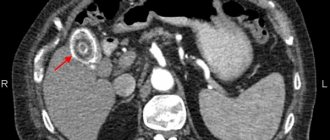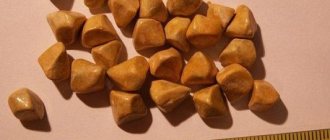What is bilirubin
Hemoglobin in red blood cells (as is known) transports oxygen. In the fetus, this occurs due to its fetal (infant) variety. The baby needs it during embryonic development. It is distinguished by its ability to bind gas molecules and release them to cells. With the birth of a child, the “old” protein is destroyed. The product of its breakdown becomes bilirubin. Its level in the blood plasma jumps, but should not exceed threshold values. Otherwise, the subcortical structures of the brain will be seriously damaged.
There are 2 types of bile pigment:
- Indirect - fat-soluble tissue poison, dangerous to the nervous system. Leads to physiological jaundice. The condition is generally considered normal, but requires constant monitoring, otherwise intoxication occurs, as well as hearing and vision impairment.
- After combining with plasma albumin, the pigment loses toxicity. It acquires water-soluble properties and ends up in the liver, where, as a result of a series of transformations, it becomes able to be excreted in the bile and excreted by the urinary system. The direct bilirubin fraction normally accounts for 90% of the total volume.
In newborns, the liver has not yet acquired maturity, and therefore cannot cope with the utilization of pigment, as a result of which its concentration increases, provoking pathological jaundice.
Reasons for increased bilirubin
While in the womb, the fetus receives oxygen not through the lungs, but directly, with red blood cells that contain fetal hemoglobin. After birth, it is destroyed and a normal one is produced. When hemoglobin breaks down, indirect bilirubin is released - a yellow bile pigment. A typical manifestation of this process is a yellowish halo that appears around the bruise, which is already beginning to fade.
Indirect bilirubin is insoluble, the body cannot remove it like other metabolic products. Liver enzymes are needed to remove it. But the baby’s liver is still immature, there are no enzymes, so bilirubin remains in the baby’s blood for some time. This is determined laboratory, with the help of tests, and visually – physiological jaundice develops.
After the hepatic system matures, the production of enzymes that bind pigment begins. Now direct bilirubin easily leaves the body along with feces, and jaundice goes away.
Norm of bilirubin in the blood of newborns
You can assess the level of pigment by considering the dynamics of its changes:
| Child's age (days) | Normal (µmol/l) | |
| up to 24 hours | up to 35 | |
| 1—2 | 20—150 | |
| 3—5 | 25—205 | |
| 7 | 145 | |
| 9 | 110 | |
| 28 | up to 20.5 | |
The data presented applies to infants born at term. For premature babies, these indicators will be different. For the latter, whose nervous system is not yet able to cope with its functions, bilirubin is dangerously toxic. For them, the maximum value is 170, for full-term ones 256 (µmol/l).
Blood for biochemical research is taken immediately after birth from the umbilical cord. Biomaterial can be taken from the hand, foot or vein on the child’s head using a needle. In premature infants, pigment levels are monitored daily.
For children without clear signs of jaundice, the color of the skin on the forehead is checked using a photocell. The disadvantage of this test is the inability to determine different fractions of bilirubin. At one month of age, the analysis is repeated.
How to reduce elevated bilirubin in newborns: treatment methods
If the level of pigment in the blood is elevated (for a long time), parents need to immediately take the baby to a specialist who can make an appropriate diagnosis and, as a result, prescribe treatment.
Several methods are used to remove bilirubin from the baby’s body:
- Phototherapy. This method involves exposing the baby to ultraviolet rays. To do this, the child is placed in a crib over which the device is located. When ultraviolet light hits a child’s skin, it helps remove pigment from the body, but during this procedure, parents should be aware that such rays can harm the baby’s vision, so his eyes should be covered with a special bandage.
- Infusion therapy. As a result of exposure of the child’s skin to ultraviolet radiation, a large amount of fluid is removed from his body, as a result of which infusion therapy is prescribed, which helps restore the water balance in the baby’s body. To do this, glucose, soda, and drugs that improve microcirculation are introduced into the child’s body.
- Enterosorbents. In this case, Smecta or Entorosgel is prescribed. This is necessary to prevent the reverse absorption of bilirubin into the baby’s blood through the intestines.
- In especially severe cases, the baby is indicated for a blood transfusion.
The selection of methods for removing pigment from the body is carried out exclusively by a doctor.
When breastfeeding, it is recommended that mothers put the baby to the breast more often, as this also helps to quickly remove pigment from the body.
Cause of elevated levels in children
A critical concentration of bilirubin may be due to diabetes mellitus in the mother, medications she takes to induce labor or eliminate bleeding. Bile pigment increases if:
- The child quickly loses weight.
- The mother refuses breastfeeding.
- There is a Rh conflict.
Other reasons:
- Low rate of plasma protein binding.
- Insufficient activity of liver enzymes.
- Excessive destruction of red blood cells.
- Immaturity of many organs.
Increased bilirubin is sometimes associated with pregnant women smoking and alcohol abuse, disruption of the embryonic development process, and taking toxic medications:
- Cytostatics.
- Hormones.
- Antibiotics.
For what reasons does deviation occur?
Long-term high bilirubin in a newborn is the result of many pathologies. Direct bilirubin is not formed for the following reasons:
- Rh conflict (negative in the mother, positive in the child);
- conflict between blood groups;
- prematurity;
- minor internal hemorrhages;
- pathology of the biliary tract or liver;
- infection intrauterine or postpartum;
- diseases of the digestive and endocrine system;
- genetic abnormalities;
- the effect of drugs administered to the mother to stimulate uterine contractions.
All these reasons negatively affect the entire body, but increased bilirubin poses a significant threat to the central nervous system. Therefore, already in the maternity hospital, if there is a suspicion of pathology, it is necessary to conduct a thorough examination of the baby and prescribe therapy. It should reduce the concentration of bile pigments and prevent serious complications.
Physiological jaundice
The condition is regarded by pediatricians as borderline, requiring close attention. Occurs in 65% of newborns. Caused by changes in the circulatory system. Yellowness of varying shades from dark to orange affects the chest, neck, and face. Appears on the second day after birth. The degree of staining may increase. The child's condition is satisfactory, he is not lethargic, and eats well. Naturally colored urine and feces. The process is characterized by a benign nature. After 7 days, the bilirubin level drops. By the 3rd week it returns to normal, the symptoms disappear, the skin becomes its usual shade.
Another harmless variety is breastfeeding jaundice. It is caused by special substances contained in breast milk. It is not necessary to transfer the baby to artificial formula feeding.
Jaundice in combination with the baby’s refusal to breastfeed, monotonous crying, convulsive twitching, anxiety, and drowsiness is a reason to urgently consult a doctor . The pediatrician should also be alert to hypotension in the child, problems with heart rhythm, and an enlarged spleen and liver.
Diagnostics
A whole range of measures has been developed for the timely detection of jaundice.
| Conversation with the expectant mother, collecting information about hereditary diseases, vaccination and transfusion history. |
|
| Determination of blood group and Rh factor. |
|
| Determination of the titer of Rh antibodies in all women with Rh-negative blood. The first study is carried out when registering for pregnancy, the second - at 18-20 weeks, in the last trimester it is recommended to check the antibody titer every four weeks. |
|
| With a high antibody titer (1:16, 1:32 and above), amniocentesis and determination of the bilirubin content in the amniotic fluid are necessary. |
|
Every woman with negative Rh blood should treat her pregnancy especially responsibly.
| Inspection | The color of the skin, mucous membranes and sclera is assessed. The sizes of the liver and spleen are determined. |
|
| Non-invasive determination of bilirubin levels in the blood | The study uses a special device for measuring bilirubin in newborns - “Bilitest”. Advantages of the device:
| Smart device |
| Laboratory research | For children at risk for developing TTH after birth:
Continuation of the examination:
If jaundice continues for more than three weeks, galactosemia must be excluded. How is blood taken for bilirubin in infants? For analysis, 5 ml of venous blood is required. After treating the skin with an alcohol solution, the blood vessel is pierced with a thin needle. The study can be carried out at any time of the day, before or after feeding. |
|
| Additional examinations | Consultation is often required:
An ultrasound examination of the abdominal cavity is also mandatory. |
|
A routine blood test is performed in the following cases:
- in premature babies born before 35 weeks;
- if jaundice appeared on the first day of life;
- for any pathological hyperbilirubinemia;
- in children with phototherapy;
- if deviations from the norm are detected using the transcutaneous method.
Indicators
Evaluation of laboratory tests and determination of treatment tactics
For newborns, the level of bilirubin depends on many factors.
These include:
- child's age;
- body mass;
- gestational age at the time of birth.
| Age | Total bilirubin (µmol/l) |
| At birth | up to 60 |
| 2 days | up to 149 |
| 3 days | up to 197 |
| On the 5th day the norm | up to 205 |
At 1 month, the normal level of total bilirubin ranges from 3.4 to 20.5 µmol/l.
Pathological jaundice
This is a severe form with a pigment concentration above 256 µmol/l. Clinical signs:
- Stool disorders.
- Regurgitation.
- Restless or extremely depressed state.
- Rich dark colored urine, light colored feces.
- Yellowness of the skin in the lower part of the body.
Types of pathological jaundice:
- Parenchymal - damage to hepatocytes (liver cells) due to intrauterine infection or other adverse effects. In 60% of cases, the provocateur is cytomegalovirus. In addition to it, the causes of the condition are viral hepatitis, rubella, toxoplasmosis, and listeriosis.
- Conjugation, which occurs due to a decrease in the binding of bilirubin to plasma albumin.
- Mechanical or obstructive - due to impaired outflow of bile, as well as defects in liver development. The skin becomes yellowish-green, the feces become discolored. The method of treatment is surgery.
- Hemolytic - against the background of Rh conflict, when the mother's antibodies destroy the red blood cells of the fetus. Accompanied by anemia, in difficult situations, tissue swelling, inhibition of reflex activity, and a sharp decrease in muscle tone. The concentration of bilirubin reaches high values. In the hospital, blood transfusions and sometimes hemosorption (plasma purification) are performed. This prevents brain damage and restores red blood cell levels. Rapid hemolytic disease can be fatal.
For any type of pathological jaundice, urgent measures must be taken.
What is bilirubin?
This is a yellow-green bile pigment, which is the result of the breakdown of red blood cells, which occurs after they have served their due period. Bilirubin has two forms - direct and indirect.
The direct form (fraction) is completely neutralized by the liver, dissolves in water and is easily removed from the body, usually with bile. The indirect fraction does not dissolve in water, is delivered to the liver through the bloodstream, easily penetrates cells and produces a toxic effect on the body.
Prevention
The health of a child is established during intrauterine development. Therefore, during this period and after childbirth, the expectant mother needs to remember and follow the following recommendations:
- Eat properly.
- Quit alcohol and smoking.
- Do not take medications without consulting a gynecologist.
- Feed your baby breast milk, which helps cleanse the intestines of toxins and form healthy microflora in it.
- Avoid constipation in your child to avoid reabsorption of bile pigment into the intestinal mucosa.
- Follow the instructions of the attending physician.
Jaundice is not a reason to refuse vaccinations, because the likelihood of hepatitis in such children is several times higher.
What types of jaundice are there?
Changes in skin color are associated with an increase in the amount of bilirubin in the blood.
Visible manifestations of jaundice:
- in adults – 26 µmol/l;
- in infants who were born at term – 69 µmol/l;
- in children born prematurely – 120 µmol/l.
Starts from the face, as hyperbilirubinemia increases, spreads to the extremities
Jaundice can be physiological and pathological.
How is a blood test performed?
A blood test for bilirubin will require venous or capillary blood.
Due to the anatomical and physiological characteristics of the child’s body, in the first days of life, blood is taken from the heel. This small amount of blood is enough for the test.
To determine the level of bilirubin, a colorimetric method is used, that is, the color of the solution is directly proportional to the concentration of the substance in the blood.
Currently, the level of bilirubin is determined using automatic analyzers, which reduces the likelihood of erroneous determination of the level of the analyzed substance in the blood.
At birth, the norm of bilirubin in the child’s blood reaches 50 – 60 µmol/l. Then its level may increase on days 3–7. By 1 month, bilirubin levels reach the normal level for adults. The table below shows the normal bilirubin level in newborns.
Table. Normal bilirubin level in a one-month-old baby.
| Age | Norm |
| 1 day | 50 – 60 µmol/l |
| 2 days | 25 – 150 µmol/l |
| 3 – 5 days | 26 – 205 µmol/l |
| 6 days | Not more than 70 µmol/l |
| 1 month | 8.5 – 20.5 µmol/l |
Reaching a bilirubin level of more than 240 µmol/l (170 µmol/l in premature babies) is a sign of the presence of pathology in the child’s body; it is necessary to urgently look for the cause before serious disorders develop in the nervous system.
Diseases with increased bilirubin
If large deviations from the norm are observed, so-called pathological jaundice, this may indicate a number of abnormalities.
- Infectious liver disease.
- Intestinal obstruction.
- Mechanical jaundice.
- Hormonal disorders.
- Gilbert's syndrome is a constitutional liver dysfunction.
- Incompatibility of mother and child by blood type.
You need to understand that only a specialist will be able to select the appropriate symptom for the situation, conduct further diagnostics, and determine whether it is necessary to treat increased bilirubin in newborns.
Table of norms for children
Today, there is a table of norms for protein content in a child’s blood developed by WHO. These data relate to total protein indicators. Direct and indirect have their own table, the indicators are different.
The following norm has been established for total bilirubin in the blood; the table below shows these indicators.
As you can see, the rate of bilirubin in the blood of newborns and children at 1 month is very different. This suggests that this protein is capable of being excreted from the body in large quantities in a short period of time.
How dangerous is the disease?
The main danger posed by increased bilirubin in the blood of a newborn is the toxic effect on the child’s body. The protein cannot be completely blocked by typical blood albumin, so it goes directly into the nervous system.
This is dangerous for vital nerve centers; due to the undeveloped blood-brain barrier, high levels of bilirubin in the newborn’s blood can enter the brain cells. There it accumulates in tissues and can cause very serious neurological damage. As a rule, bilirubin encephalopathy manifests itself during the first days of a baby’s life.
The main signs of the disease are:
- decreased sucking reflex;
- severe drowsiness.
The fact that bilirubin in a newborn is not normal and its limit has already been reached is indicated by such a sign as a significant decrease in blood pressure, as well as motor restlessness, which may be accompanied by convulsions. Sometimes there is an enlargement of the liver and spleen.
If the baby’s treatment is started at the wrong time or is not carried out at all, then:
- there is a risk of the baby losing hearing by 6 months;
- mental development slows down;
- At the acute stage of the disease, paralysis develops.
High bilirubin in the blood of newborns is a serious cause for concern and observation by a neurologist, but not a reason for panic - the protein level most often comes very quickly to the desired levels.
How to treat the disease?
Doctors from the maternity hospital begin treatment. According to blood tests, the indicators are compared with the table, determining whether bilirubin in children is normal or within its limits. Treatment begins immediately as soon as the distance from the norm is sufficiently large, fearing a further increase in the child’s protein concentration.
The most effective and harmless treatment method used by today's pediatricians is light therapy or phototherapy. The method is effective for physiological jaundice when a blood test indicates slight deviations from the norm.
The basics of phototherapy are that under the influence of ultraviolet rays, the indirect protein is almost immediately converted into lumirubin, which is no longer perceived by the body as a toxin, and is then removed from the body along with feces and urine in about 12 hours. This method has unpleasant side effects - loose stools and severe flaking of the baby's skin. However, these signs do not last long.
Another effective method is treatment with breast milk. Since the described protein is fat-soluble, and there is a lot of these fats in mother’s milk, it is this useful source that can influence its level and the complete recovery of the child. Therefore, knowing what bilirubin should be in her newborn and comparing it with tests, the mother can immediately begin her own method of treatment.
Attention!
The information published on the website is for informational purposes only and is intended for informational purposes only. Site visitors should not use them as medical advice! The site editors do not recommend self-medication. Determining the diagnosis and choosing a treatment method remains the exclusive prerogative of your attending physician! Remember that only complete diagnosis and therapy under the supervision of a doctor will help you completely get rid of the disease!
Bilirubin is a special pigment formed due to the destruction of protein structures in the blood. Its distinctive feature is its yellow-brown tint. You can observe manifestations of bilirubin on the skin after the formation of a bruise, on days 9-10. Yellowish spots can be seen around the injury. Bilirubin is not dangerous to the body if it is systematically excreted through urine and feces. Its presence is permanent; a small amount of pigment is not harmful to health.
Physiological jaundice in a newborn
What is dangerous about elevated bilirubin levels?
With low liver activity or significant breakdown of hemoglobin in a newborn, an excessive amount of toxic bilirubin, not associated with albumin, begins to circulate in the blood. It has a detrimental effect on the structures of the nervous system. The effect on the brain is especially dangerous. In this case, we are talking about bilirubin encephalopathy or kernicterus. Manifestations of this condition will be the child's drowsiness, lethargy and weak sucking reflex. In severe cases, convulsive syndrome, mental retardation and deafness may develop.

